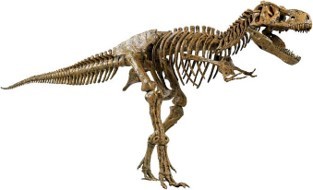Tyrannosaurus rex has been known to science since the end of the nineteenth century, and to this day remains arguably the most popular dinosaur the world over. This is evidenced by its almost mandatory inclusion in books, TV shows, games and websites that are about dinosaurs in general. Tyrannosaurus also probably has more toys and merchandising relating to it than any other dinosaur.
Although Tyrannosaurus has lost the epithet of largest carnivorous dinosaur to others like Giganotosaurus and Spinosaurus, it still remains the largest from North America, and still sits among the biggest known carnivorous theropods. The largest recovered specimen of Tyrannosaurus is an 85% complete individual nicknamed 'Sue' after its discoverer, and measures a total length of 12.3 meters. However the largest Tyrannosaurus skull measures 1.5 meters long, bigger than 'Sue's' skull that measures 1.41 meters long. This Skull is 6 per cent bigger than 'Sue', and by scaling up 'Sue's'' body length by the same percentage, gives a potential total body size of up to 13 meters long. It should be remembered however that the maximum size of Tyrannosaurus, and indeed other extinct creatures, needs to be attributed to fossil material of a size that fits the estimate, otherwise it can only remain as speculation.
Not only is 'Sue' 12.3 meters long, study of the fossils has revealed that 'Sue' was 28 years old at the time of death. This is considered to be old for a Tyrannosaurus, with maximum age estimates for the genus usually stopping at 30 years old. It could still be that Tyrannosaurus potentially grew bigger than the confirmed 12.3 meters long by the way it grew up. There are a large number of fossils not just for Tyrannosaurus, but for the tyrannosaurid group as a whole, that represent individuals of different ages and their corresponding sizes. When these sizes and ages are put together, an S shaped growth curve is clearly displayed. This indicates that for roughly the first third of their lives, the tyrannosaurids grew quite slowly, reaching about a tenth of their full potential size. When they became teenagers however, they underwent a massive growth spurt, reaching nearly their full adult size in only about ten years. After this spurt, the rate of growth levels off as dramatically as it began when the individual reaches approximately twenty years of age.
While this is a common trait for the tyrannosaurid group, the rate of growth for Tyrannosaurus is even greater than the smaller tyrannosaurids like Gorgosaurus. This is even more spectacular when you consider that Tyrannosaurus is not thought to have lived any longer than its smaller brethren, but still grew meters longer, and several tons heavier.
One of the most controversial theories about Tyrannosaurus is if it was actually a predator at all, but instead lived the life of a scavenger. Some have said that its size, even when combined with lower weight estimates meant that it could not run, as in both feet off the ground at the same time. Biomechanical studies have also shown that it was no way near as fast as it is sometimes depicted in movies. It is popularly said that for a Tyrannosaurus to run at 25 miles per hour, it would need up to of around 80% of its muscle mass in its legs, an unheard of scenario. What are considered more realistic estimates place top speed at around the 11 miles per hour mark.
A slower than expected speed does not mean that Tyrannosaurus was a scavenger however. You have to remember that predators need to be only fast enough to catch their prey. Many of the primary prey species of Tyrannosaurus were hadrosaurs like Edmontosaurus, ceratopsians like Triceratops, and maybe even armoured dinosaurs like Ankylosaurus. These dinosaurs were built for browsing on vegetation, not speed. Even though hadrosaurs are considered to have been optionally bipedal when the situation arose, and some think that ceratopsian dinosaurs could run fast in a similar fashion to a rhinoceros, if they still could not out run a Tyrannosaurus whether through injury, old age or just inability, they would almost certainly still be on the menu.
04 Feb 2020

